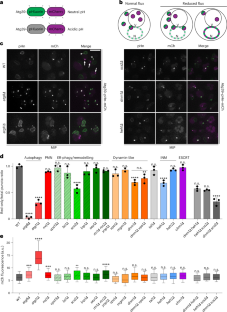A quantitative ultrastructural timeline of nuclear autophagy reveals a role for dynamin-like protein 1 at the nuclear envelope
IF 17.3
1区 生物学
Q1 CELL BIOLOGY
引用次数: 0
Abstract
Autophagic mechanisms that maintain nuclear envelope homoeostasis are bulwarks to ageing and disease. Here we define a quantitative and ultrastructural timeline of nuclear macroautophagy (nucleophagy) in yeast by leveraging four-dimensional lattice light sheet microscopy and correlative light and electron tomography. Nucleophagy begins with a rapid accumulation of the selective autophagy receptor Atg39 at the nuclear envelope and finishes in ~300 s with Atg39-cargo delivery to the vacuole. Although there are several routes to the vacuole, at least one pathway incorporates two consecutive membrane fission steps: inner nuclear membrane (INM) fission to generate an INM-derived vesicle in the perinuclear space and outer nuclear membrane fission to liberate a double-membraned vesicle to the cytosol. Outer nuclear membrane fission occurs independently of phagophore engagement and instead relies surprisingly on dynamin-like protein 1 (Dnm1), which is recruited to sites of Atg39 accumulation by Atg11. Loss of Dnm1 compromises nucleophagic flux by stalling nucleophagy after INM fission. Our findings reveal how nuclear and INM cargo are removed from an intact nucleus without compromising its integrity, achieved in part by a non-canonical role for Dnm1 in nuclear envelope remodelling. Mannino et al. provide a quantitative and ultrastructural timeline of nucleophagy in yeast with lattice light sheet microscopy and correlative light and electron tomography. They identify a role for dynamin-like protein 1 in outer nuclear membrane fission.


求助全文
约1分钟内获得全文
求助全文
来源期刊

Nature Cell Biology
生物-细胞生物学
CiteScore
28.40
自引率
0.90%
发文量
219
审稿时长
3 months
期刊介绍:
Nature Cell Biology, a prestigious journal, upholds a commitment to publishing papers of the highest quality across all areas of cell biology, with a particular focus on elucidating mechanisms underlying fundamental cell biological processes. The journal's broad scope encompasses various areas of interest, including but not limited to:
-Autophagy
-Cancer biology
-Cell adhesion and migration
-Cell cycle and growth
-Cell death
-Chromatin and epigenetics
-Cytoskeletal dynamics
-Developmental biology
-DNA replication and repair
-Mechanisms of human disease
-Mechanobiology
-Membrane traffic and dynamics
-Metabolism
-Nuclear organization and dynamics
-Organelle biology
-Proteolysis and quality control
-RNA biology
-Signal transduction
-Stem cell biology
 求助内容:
求助内容: 应助结果提醒方式:
应助结果提醒方式:


